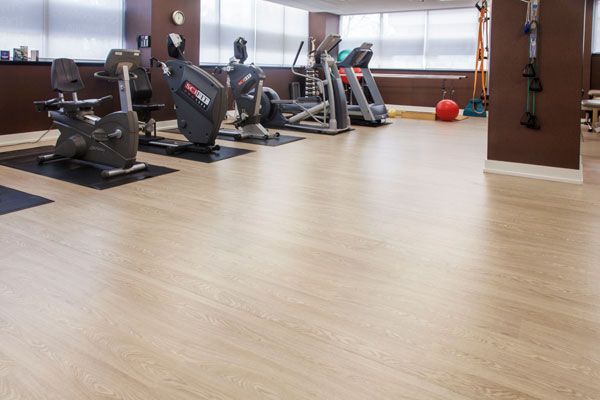New Trends in Resilient Flooring for Healthcare Environments
The right flooring can make a major contribution to a positive healing environment for patients, a productive workplace for staff, and the safety and well-being of both
![]() Continuing Education
Continuing Education
Use the following learning objectives to focus your study while reading this month’s Continuing Education article.
Learning Objectives - After reading this article, you will be able to:
- Discuss major changes in the healthcare industry with a direct impact on design and product selection, including a strong emphasis on patient well-being, satisfaction, and outcome.
- Analyze unique performance requirements of flooring in healthcare environments and their close relationship to the safety and comfort of patients and staff.
- Evaluate different types of resilient flooring for specific healthcare applications, including new technologies that are changing familiar products to improve performance, sustainability, and patient experience.
- Select flooring that contributes to effective, evidence-based environments for healing.
Afew years ago, a boom in capital construction was predicted to provide an aging population with additional beds. Now, although large new hospitals are still being built, by far the greatest growth is in renovation, modernization, and the construction of new, specialized spaces, such as outpatient clinics and units focusing on specific needs.
Two of the major trends affecting the design of these new spaces sometimes seem to be in direct conflict. A large body of knowledge now exists documenting how the physical environment of a healthcare facility directly affects patient outcomes. Evidence-based design can promote healing, safety, and a positive experience for patients, families, and staff. At the same time, cost constraints are more severe. It seems the more healthcare design, products, and materials can do, the less money there is to pay for them.
But the changing structure of the healthcare industry is also rewarding the use of evidence-based design in many important ways. Healthcare is shifting from a fee-for-services model to a fee-for-performance model. Under the Affordable Care Act (ACA), costs associated with avoidable incidents, such as hospital-acquired infections (HAIs) and slip/fall injuries, are not reimbursable and are borne by the healthcare provider. Medicare payments are linked to factors, such as scores on patient satisfaction surveys, length of hospital stays, and the number of readmissions. Many private insurers are following suit. Reimbursement at risk has created a healthcare dynamic where the emphasis on efficiency must be paired with quality and patient satisfaction.
Part of the answer is more choice in products that can contribute to good outcomes while controlling costs. The selection of flooring will directly affect major components of safety and satisfaction for both patients and staff, including acoustics, protection from injury, prevention of HAIs, and creating a safe, positive healing environment. The same choices will result in cost saving and efficiency through better patient experiences, improved staff efficiency and retention, reduced liability for infection and injury, and reduced costs for maintenance and energy.
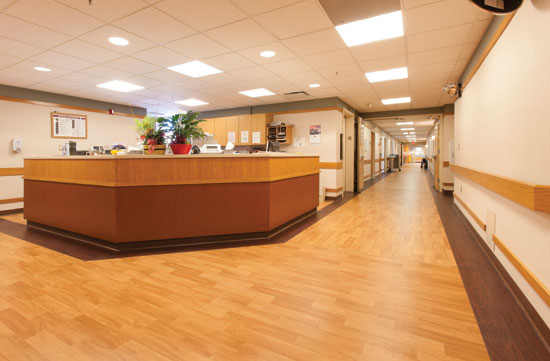
Photo courtesy of Ecore Commercial Flooring
Nurses station and hallway at the Vernon Memorial Healthcare (VMH) medical building in Viroqua, Wisconsin. No-wax sheet vinyl flooring with the appearance of wood planks was chosen for performance characteristics as well as a warm, natural look.
Not long ago every floor in a hospital might be covered with a single material, often the same sterile institutional color. It was probably noisy and hard, with no particular connection to the mission of the facility. Now there are specialized resilient flooring solutions available for every application.
This course will consider three important factors in selecting a resilient floor for a healthcare environment: current construction and design trends, the evidence-based performance requirements of each space, and the different types of resilient flooring that are available, including new technology that is transforming familiar products and creating new options.
Floors for New Spaces
The growth in healthcare construction is centered in new outpatient settings and new specialized spaces within existing hospitals. Medical services are being relocated to the community as part of a population-based approach to medicine. The formation of new Accountable Care Organizations (ACOs), where voluntary groups of primary physicians, specialists, and hospitals work together to provide patients with coordinated, integrated care, often brings new outpatient units into partnership with larger hospital systems.
Buildings originally built for other purposes are being renovated to become neighborhood primary care or urgent care clinics (for example, the Formé Urgent Care and Wellness Center building, featured in a sidebar in the online version of this course, previously housed the White Plains Building Department). Some ambulatory care centers (ACCs) offer all the services available in an acute care hospital with the exception of overnight stay. They are far faster and less expensive to build than new hospital wings, and can be designed for flexibility and expansion if markets grow or change.
Within hospitals, spaces are being reconfigured to improve processes, to meet new purposes, and to make changes that will lead to lower costs in cleaning, maintenance, and energy. The 2015 Hospital Construction Survey1 indicates that “more than half of hospitals and health systems are repurposing space, or considering the idea, as they transition to value-based payment models and take the reins of population health management in their communities.”
Examples of this trend include:
► Stand-alone emergency departments
► Ambulatory surgery centers
► Medical offices for targeted procedures
► Specialized services, e.g., dialysis, infusion
► Community primary and urgent care centers
► Behavioral health units
► Bariatric care
► Acuity-adaptable rooms
► Rehabilitation and physical therapy centers
► Diagnostic and imaging centers
Facilities like ACCs combine areas for different purposes, and require specific flooring for each. Treatment and procedure rooms require the same seamless germ-free flooring as a sterile hospital operating room. Laboratories and imaging facilities may require flooring that controls electrostatic discharge (ESD).
All require ergonomically effective and easy-to-clean patient rooms and staff areas, noise-dampening corridors, cost-efficient utility and pharmacy areas, and waiting and consultation areas that are welcoming and reduce stress. As discussed later in this course, research has shown that “waiting” is an activity that can have a significant impact on family engagement and patient outcomes. In fact, the attractiveness of the lobby has been found to affect a patient's perception of the quality of care, even including the length of the wait.
Renovation within hospitals often concentrates on reconfiguring and equipping space for better workflow and to meet new priorities in care.
For example, evidence indicates that many patients have better outcomes in single rooms, and when they can stay in one room throughout the different stages of their care. This is known as “acuity adaptable.” These rooms are equipped with sources of power and medical gases, but portable equipment can be moved in and out for every purpose from bedside diagnostics to critical care. This offers the patient quality care with minimum time and effort spent waiting, preparing, and being moved around to other sections of the hospital. Rooms like this require flooring that is durable, adaptable, easy to clean on a daily (or hourly) basis, and able to withstand heavy equipment without damage or indentations, while providing roller mobility and allowing staff to maneuver equipment easily.
Parallel to the growing shift towards the integrated ACO model of healthcare is a more holistic, preventative approach that extends the concept of healthcare beyond its traditional definition as treatment for emergency or disease. Rehabilitation and physical therapy areas meet the needs of the large segment of the population getting joint replacements and other procedures, but they also respond to an emphasis on healthcare for wellness as opposed to medical intervention. Specialized resilient flooring is required for weights, heavy equipment, pools, and water therapy.
Behavioral health units, whether in psychiatric facilities, specialized hospital units, or drug and alcohol rehabilitation centers, require calming, soothing interiors, including cushioned floors and sound dampening for floors, walls, and ceilings to relieve patient anxiety and agitation.2 These materials must also resist being ripped up or used by patients to injure themselves or others. An example is flooring with impact-resistant bonded construction and superior peel strength.
Flooring in bariatric rooms that provide the special care and equipment needed for the increasing number of obese patients must not deform or peel. Facilities focusing on the needs of the elderly, such as new geriatric emergency departments designed for the 15-20 percent of emergency room patients over 65, require slip-resistant safety flooring, increased lighting, and attention to wayfinding.
Different types of flooring may be required not only in the same building, but at times within the same space. For example, different textures and colors can be used to indicate level changes to assist in wayfinding or to help prevent stumbles and falls.
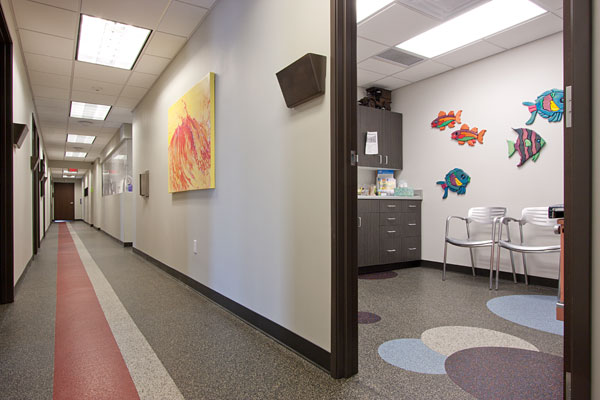
Photo courtesy of Ecore Commercial Flooring
Healthy Outlook Family Medicine, P.C., located in Phoenix, Arizona. Studies indicate that the attractiveness of the surrounding, as in this exam room with recycled rubber flooring, has a positive impact on patient perceptions about quality of care.
Evidence-Based Flooring
The 2004 landmark study “The Role of the Physical Environment in the Hospital of the 21st century,” sponsored by the Center for Health Design and the Robert Wood Johnson Foundation, reviewed more than 600 studies documenting the direct connection of the physical environment to patient healing and staff effectiveness.3 Since then, hundreds of other studies have confirmed the value of evidence-based design in healthcare settings. Noise, glare, poor air quality, and depressing and chaotic surroundings create stress that can be measured in real terms: heart rate, blood pressure, oxygen, and stress hormone levels in blood, time for wound healing, sleep quality, the need for pain drugs, the number of medical errors, and the frequency of HAIs can all be affected.
When good design and effective products reduce stressors, healing is promoted and the staff is more productive. Fortunately, there are strong financial incentives in the current healthcare system for making these improvements. As mentioned previously, Medicare payments are now linked to factors such as scores on patient satisfaction surveys. In 2015, 30 percent of the score on the Hospital Consumer Assessment of Healthcare Providers and Systems (HCAHPS) survey is based on how patients rate their care experience.4 Cleanliness and quiet are two major areas evaluated in the surveys. “Five Star” ratings on hospital comparisons are also being added.
Preventable injuries and infections during hospitalization are no longer reimbursed, so providers have higher liability risk. Recommendations from the Agency for Healthcare Research and Quality (AHRQ)5 identify prevention of patient falls, reduction of infection, and prevention of medication errors as areas of emphasis of evidence-based design to improve patient safety and quality of care. Use of specialized hospital flooring to prevent patient falls and reduce injury when falls do happen is specifically mentioned as a promising practice recommended for further research by this agency.
Flooring selected specifically for ergonomics and safety in healthcare settings can also improve staff productivity, safety, and retention. Caregiver fatigue, injury, and stress are tied to a higher risk of medication errors and patient infections. Safer workplaces translate to safer care. Studies have found higher patient satisfaction levels in hospitals where fewer nurses are dissatisfied or burned out.6
The retention of staff is becoming a critical issue in the healthcare industry, not only for trained nurses, but even for cleaning personnel and facility managers. High turnover is a problem for the delivery of care and also a major cost. According to the 2015 National Healthcare and RN Retention survey,7 the average cost of turnover for one bedside RN ranges from $44,380 to $63,400.
Evidence-based design covers a wide spectrum of factors, from workflow processes to room layout to information technology. In the following sections, we focus on four specific ways resilient flooring can contribute to a healthcare facility's mission while saving costs:
► Reducing noise
► Preventing injury
► Increasing cleanliness and controlling infection
► Creating a positive healing experience in every respect, from attractive surroundings to good indoor air quality
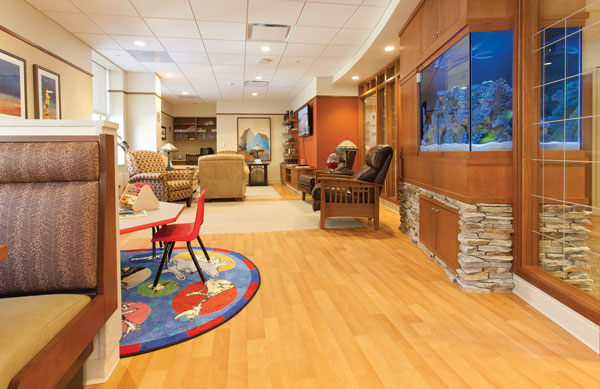
Photo courtesy of Ecore Commercial Flooring
St. Mary’s Hospital, Madison, Wisconsin. During renovation and the building of a new wing, carpet was removed throughout hallways and patient rooms, and replaced with 60,000 square feet of a no-wax sheet vinyl product providing the look of wood with an advanced lifetime no-wax finish. St. Mary’s combines many different specialized areas. Shown here, the Ronald MacDonald Family Room, designed as a place of respite for families of critically ill children in the nearby pediatric and neonatal intensive care units, has been designed to be especially quiet, home-like, and reassuring.
Acoustic Performance
“We are now witnessing a transformation in healthcare reimbursement to a 'pay for performance' model. Design and construction mandates related to acoustics can be expected to enhance performance through more accurate communication, increased speech privacy and HIPAA compliance, lowered staff stress levels, decreased medical errors, and limited patient sleep disruption. Together these should produce better clinical outcomes, reduce staff turnover rates, and provide advantages in the competitive marketplace, all of which carry positive cost implications.”
Validating Acoustic Guidelines for Healthcare Facilities
The Center for Health Design, 2010
Everyone intuitively understands that healing is more likely to take place in a calm, quiet atmosphere. But the high-tech, intense atmosphere of a hospital, filled with the noise of medical equipment, clattering carts, and echoing voices, can be the opposite of that. A Johns Hopkins study found that “regardless of country, type, or size of hospital, type of patient care unit, or time of day, there is a fairly narrow range of sound levels in hospitals, and all exceed recommended levels.”
A noisy, confusing hospital room can raise patients' blood pressure, heart rate, and muscle tension. Hormones released in response to stress can suppress the immune system, causing wounds to heal more slowly. A question on the HCAHPS patient satisfaction survey directly addresses “Quietness of Hospital Environment.”
As a result, hospitals are attempting to reduce the sources of noise on every front possible, e.g., limiting overhead paging and cell phone use, relocating ice makers and other 24-7 noise sources and wrapping ducts. The most direct way to improve the quiet surroundings in a patient's room is by soundproofing the ceilings and flooring.
Until very recently, “quiet” flooring meant carpet, the most absorptive flooring material. Although often used for that reason, carpet also has drawbacks in healthcare settings, such as difficulty cleaning and disinfecting, and adding to staff workload by making equipment more difficult to maneuver. Carpet can't be used in sterile environments like operating and treatment rooms. As a result, a major focus of resilient flooring research has been a technology that could provide the same acoustic properties as carpet but with the safety, ergonomic, and hygiene advantages of resilient flooring.
A recent study by The Acoustics Laboratory at the University of Hartford in Hartford, Connecticut,8 examined the acoustic performance of flooring products, using common sources of hospital noise. The study found that flooring composed of a no-wax sheet vinyl fused to a 90 percent post-consumer recycled rubber backing provided the same quiet as carpet.
A standard indicator of acoustic performance is absorptivity, a measure of how much sound is absorbed by the material. Resilient flooring can't match carpet's absorptivity, but researchers established that there are other ways to measure the amount of sound generated by the surface, and thus the actual overall quietness of a room.
The project aimed to quantify the effect that different flooring materials could have on hospital corridor noise: the footfall from staff and visitors and the rolling noises from medical carts and other equipment. Different tests were performed on each test material: an absorption test (ASTM C423), a tapping machine test, and a rolling cart test.
Five different products were tested:
► Commercial carpet tiles, rubber-backed
► Sheet vinyl with no rubber backing
► Sheet vinyl flooring surface fusion bonded to recycled rubber backing
► Standard vulcanized rubber flooring with no backing
► Vulcanized rubber fusion bonded to recycled rubber
The absorption test, as expected, found that carpet was the most absorptive material.
The test to measure the amount of sound generated by the surface used a standard tapping machine, the same equipment typically used when conducting field tests for Impact Insulation Class ratings. The results of this test confirmed that the vinyl surface fusion-bonded to the recycled rubber backing improved sound levels significantly, close to the levels generated by carpet.
In the rolling cart tests, a specially built mechanism repeatedly and consistently rolled a standard stainless steel hospital cart across the floor samples. Again, the rubber-backed sheet vinyl flooring produced almost the same amount of sound as the carpet (technically slightly less). (See chart.)
According to the study's final report, the combination of the no-wax sheet vinyl flooring with the recycled rubber backing “resulted in an overall sound power level reduction of 16 dB(A) during the tap test and an overall reduction of 5 dB(A) during the rolling cart test...nearly identical sound power spectra as the carpet.”
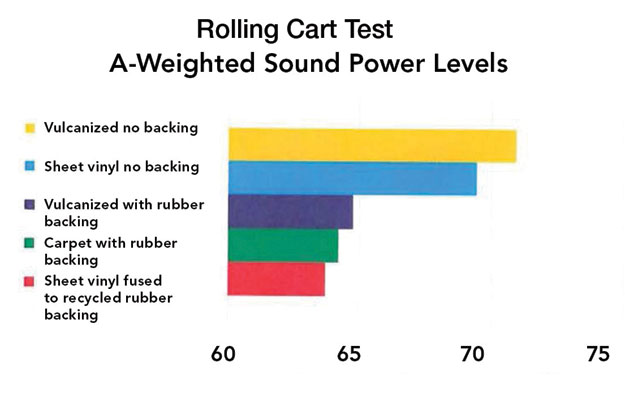
Image courtesy of Ecore Commercial Flooring
Safety First
Falls and fall injuries in hospitals are the most frequently reported adverse event among adults in the inpatient setting, and they account for substantial cost and liability to healthcare providers. Between 700,000 and 1 million patients suffer a fall in U.S. hospitals each year, according to the Agency for Healthcare Research and Quality.9 Between 30 and 51 percent of falls result in an injury. The cost to a hospital stay for a severe injury is an estimated $27,000 per event, and Medicare does not reimburse hospitals for any part of the extra care associated with an inpatient fall. Beyond the financial impact, the effect a serious fall has on the patient's quality of life after the event is often extremely damaging. Full recovery is rarely realized and a disability often results.
Slips, trips, and falls (STFs) also take a severe toll on hospital staff: They are the second most common cause of injury to staff (next to injuries such as sprains and strains from patient handling). According to OSHA, U.S. hospitals on average record about 6.8 work-related injuries and illnesses for every 100 full-time employees, a rate almost twice as high as private industry as a whole.10
An estimated 12 percent of nurses leaving their profession do so because of back injuries, and more than 50 percent complain of chronic back pain.11 Flooring that works to prevent falls also contributes to ergonomic comfort, reducing fatigue and preventing back pain.
A study of hospitals in England in 2010-201112 evaluated shock-absorbing flooring materials for its effect on fall-related injury severity, rates, and adverse events. The intervention group experienced less than half as many injurious falls as the control group.
Preventing falls involves process and patient factors as well as environmental ones, but safe flooring is an essential piece.13 Although the magnitude of the problem may seem to argue for padding all healthcare facilities with the softest, thickest floors available, flooring selection is more complicated than that. Flooring that is too soft can present a mobility problem for wheelchairs, those using walkers, and for others with difficulty walking, due to age, injury, or medication.
Soft floors also can create fatigue and injury among staff moving heavy equipment. Even low-nap carpet can require significantly greater effort to push heavy equipment or bariatric patients than a smooth, hard surface. Test results indicate that resilient flooring, such as recycled rubber or vinyl with a recycled rubber backing, can provide shock-absorbent flooring and ergonomic performance with effective push-pull properties.
The Center for Disease Control (CDC) study “Slip, Trip and Fall Prevention for Healthcare Workers” makes several recommendations, such as using slip-resistant safety flooring in areas exposed to water, grease, or particulate matter. Other CDC recommendations for safety include creating visual inserts for flooring level clues and replacing flooring that could be hazardous, in particular indented vinyl, tile with holes from equipment or furniture, and buckled or warped carpet.
Traditional vinyl flooring with foam backing often has compression problems, indentations, punctures, and visible seams. Rubber flooring, and new types of vinyl flooring with a recycled rubber backing, will indent but immediately recover and offer a range of surface textures for different needs. Both rubber flooring and safety flooring provide slip resistance, so there is less need for small mats that can be tripping hazards and trap bacteria.
Despite an industry-wide comprehensive effort to reduce falls, the number is still high and remains a critical concern for providers and insurers (and, of course, patients). When falls cannot be prevented, advanced flooring can still reduce the severity of the patient's injury. Testing on a resilient flooring product with a vinyl flooring surface fusion-bonded to a recycled rubber backing found that fall impact was reduced 16.9 percent (in accordance with DIN 18032).14
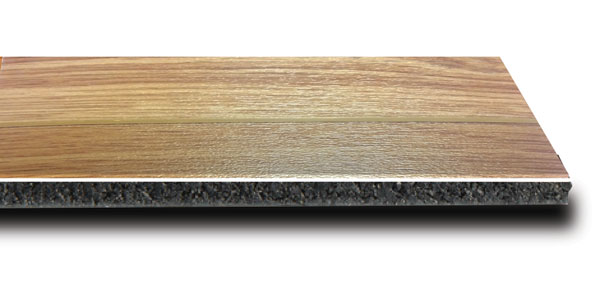
Image courtesy of Ecore Commercial Flooring
No-wax vinyl flooring fusion-bonded to recycled rubber backing for enhanced acoustic performance and reduction of fall injuries.
Cleanliness and Controlling Infection
Healthcare acquired infections (HAIs) affect an estimated 2 million people in the U.S. each year, and an estimated 99,000 lives are lost, resulting in healthcare costs of nearly $20 billion a year.15
Although some types of HAI are declining, new strains of antibiotic-resistant bacteria are causing infections that are more difficult to cure. In 2015, hospitals experienced reimbursement reductions—about $330 million—for infection rates that exceed federal standards.
There is general consensus and increasing evidence that the design of the built environment plays an important role in preventing HAIs in healthcare facilities. As with other aspects of patient safety, much of the effort to reduce infection centers on protocols and process. Preventing HAIs involves procedures as well understood as hand washing and as high-tech as hydrogen peroxide vapor systems and UV light systems on wheels. But flooring materials are a major component in every healthcare space. Older flooring materials like carpet can absorb moisture and are difficult to disinfect. Older vinyl, vinyl composition tile (VCT), and linoleum floors require continuous applications of finish to clean, disinfect, and preserve the floor.
New types of resilient flooring eliminate the need for field-applied polishes and finishes, and these surfaces support an effective cleaning regimen requiring less labor and minimal chemicals. Dirt tends to stay on top of dense materials like rubber and does not permeate the material, so it is easier to keep clean and disinfected. Safety flooring that contains antimicrobial agents, including products that have been independently tested for the ability to inhibit the growth of MRSA, is particularly important on flooring that might be wet or exposed to fluids. Vulcanized rubber flooring with heat-welded seams is ideal for sterile applications, such as operating rooms.
The Healing Effect of Beauty and Comfort
The patient experience has garnered much attention in recent research, particularly since ACA tied reimbursements and incentives to patient experience as measured by HCAHPS scores. Providers are also reacting to the rapidly evolving ease of comparing, reviewing, and discussing hospitals and other facilities online as patients research their options when planning elective procedures or hospital stays. Failure to meet the patient's expectations now directly impacts the provider's bottom line.
Multiple studies over the years have confirmed that the healing effect of beauty in the physical environment is a result of many factors, from the layout of the room to the artwork on the walls. A Cornell University study16 assessed one aspect of the relationship between the physical attractiveness of outpatient facilities on patients' perceived quality of care, noting, “In no other type of facility has design been shown, through systematic research, to have such a significant effect on outcomes considered essential to the long-term survival and performance of the organization.”
The study collected data from 750 patients in six outpatient practices where the facilities varied significantly in physical attractiveness. The results showed that patients' perceived quality of care was higher in more attractive rooms, and their perceived waiting times were shorter than the actual times. Their ratings on the quality of their interaction with staff—considered the most important factor influencing the perception of quality of care—were also consistently higher in more attractive settings.
As previously discussed, floors can help reduce stress, provide comfort, and improve sleep by reducing noise. The aesthetic value of attractive flooring can also evoke positive psychological perception. Resilient flooring is available in a wide range of colors, patterns, and textures, and can be custom designed with high-definition printing and embossing technology and computer-aided water-jet cutting. Different textures and surfaces of resilient flooring can be used for transitions between spaces while still being a part of a comprehensive design.
For example, the importance of a happy, welcoming, colorful environment is a high priority at St. Vincent Children's Hospital in Indianapolis, Indiana. This is reflected in their installation of recycled rubber flooring in vibrant patterns in the lobby area, emergency department, and corridor. The look is kid-friendly. The floor has the required performance requirements of resistance; but, just as importantly, it has an inviting quality intended to make every patient entering the facility feel comfortable and at ease.
In spaces especially designed for people with reduced acuity due to age, disease, or injury, wayfinding is critical. Returning veterans, young people with special needs, and a large aging population can all be helped when design and materials are used carefully to define the physical environment. In these spaces, flooring like recycled rubber or no-wax sheet vinyl with many available colors, patterns, and textures can be used to create pathways, environmental cues, and “decision” points.
Often high-gloss flooring finishes are not the best choice. This can be surprising, since in the past, shiny floors were often considered to be a sign of cleanliness. In reality, glare can be a significant stressor and a constant visual annoyance that is tiring for patients and staff. The Facility Guidelines Institute's Guidelines for Design & Construction of Healthcare Facilities recommend that highly polished flooring or flooring finishes that create glare should be avoided.
Flooring selection also directly affects the creation of a positive healing environment by supporting healthy indoor air quality. Hospitals go to great effort and expense to create a healing environment that is protected from outside pollutants, allergens, and toxic chemicals. Sophisticated filtration and state-of-the-art HVAC systems are the first line of defense. At the same time, products used within the space, from equipment to finishes, can also release harmful substances.
Chemicals used in cleaning are a particular challenge in healthcare settings, where patients are especially vulnerable and may have compromised immune systems, allergies, or sensitivities to certain odors. Cleaning can be very disruptive for the staff and patients. Eliminating the strip/wax/buff maintenance cycle eliminates chemical fumes and also lowers operation costs.
Rubber floors are dense and dimensionally stable, so they can be kept clean without finishes, coatings, or waxes to seal the surface. Advanced vinyl products are manufactured with high-performance flooring surfaces that eliminate the need for harsh chemicals and disruptive processes.
The adhesives used when installing a floor also affect indoor air quality. For example, two-part urethane or epoxy adhesives with a long curing time are often used to prevent indentations in soft vinyl and linoleum flooring. Some manufacturers offer a solvent-free one-part urethane adhesive that meets stringent zero-VOC standards and other benefits, such as very low odor, improved tack properties for easier application, and flat, concealed seams for easy cleaning and disinfecting. An impact-resistant bond with high peel strength makes it a good addition to behavioral health settings or other units requiring extra safety measures. The adhesive is moisture-cured and permanently elastic, providing excellent adhesion to elastomers, concrete, and wood.
All floorcovering, adhesives, and sealants in healthcare settings should meet the stringent VOC standards of the Collaborative for High Performance Schools (CHPS) criteria, as described in the State of California's Department of Health Services Standard Practice. Products should also meet USGBC LEED for the Building Design and Construction-Healthcare standards (LEED, 2014), and contribute to points for low-emitting materials under the Indoor Environmental Quality category. All cleaning products specified should met Green Seal GS-37 and GS-40 standards (Green Seal, 2011).
Resilient flooring that meets high environmental standards throughout the entire manufacturing process, including raw material supplies, is available. Flooring products that are manufactured by companies committed to sustainable materials and processes, and that meet the evidence-based criteria in this course, are likely to contribute to points in all LEED versions under two categories: Material & Resources dealing with conservation, purchasing and waste management, and Indoor Environmental Quality, which includes conditions inside a building, such as air quality, lighting, thermal conditions, ergonomics, acoustics, and their effect on occupants. Manufacturers should provide detailed support in the use of their products to help achieve LEED certification.

Image courtesy of Ecore Commercial Flooring
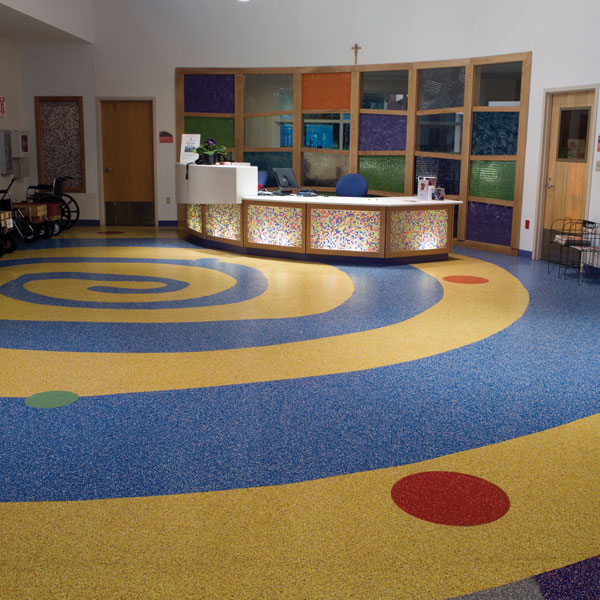
Photo courtesy of Ecore Commercial Flooring
The flooring chosen for St. Vincent Children’s Hospital resists scuffing, scratching, gouging, and indentation, and provides support and fatigue-reduction for staff. But mainly, it’s designed to make children and their families feel happy and get well soon.
Types of Resilient Flooring for Different Applications
As discussed, resilient flooring meets the increasingly exacting standards of performance required in healthcare settings. But the range of resilient flooring products available is extremely wide, offering different performance profiles for different applications.
There are three basic categories of resilient flooring that are effective in healthcare settings:
► Rubber (both flooring and underlayments), including vulcanized rubber and recycled rubber
► No-wax vinyl, including homogenous (solid) and heterogeneous (composed of more than one layer). This includes new solid vinyl tile (sometimes called “luxury vinyl tile” or LVT) and decorative solid vinyl tile (SVT)
► Safety flooring
Although most of these flooring types have been used for decades, recently new technologies are significantly expanding the options.
Each category has different strengths. The following is a summary of some common applications and recent innovations.
Rubber Flooring
Vulcanized rubber sheet flooring with heat welded seams is the only rubber flooring product suitable for a sterile environment or an area where bodily fluids might be present, including operating rooms, laboratories, and procedure rooms. Vulcanized rubber is not porous and does not have seams, so dirt and germs cannot penetrate the floor.
Vulcanized rubber tiles, on the other hand, are suitable for most non-sterile areas, and are often used in lobbies, waiting rooms, and stair treads.
Recycled rubber is an extremely sustainable product that also provides specific acoustic, ergonomic, and fall protection benefits. Some manufacturers create unique performance surfacing from reclaimed waste, such as tires and post-industrial and post-consumer waste. Solid recycled floors are available in a virtually limitless range of colors and patterns and can be custom designed and cut.
The most advanced recycled rubber surfaces offer force reduction, energy return, durability, and sustainability. They can typically be recycled at the end of use and made into new flooring. Available in sheets or tiles, recycled rubber flooring can be selected for virtually any non-sterile area. The inherent sound-reducing quality of rubber helps to minimize the sound of footfalls, making it the preferred choice for large public areas like lobbies, waiting rooms, hallways, and cafeterias. Its ergonomic properties make it effective in all areas where staff is standing for long periods.
Specialized recycled rubber flooring (along with some vinyl products) is often specified for technical medical spaces, such as server and other computer rooms, imaging rooms or diagnostic centers, because it protects sensitive equipment from damage caused by electrostatic discharge.
Acoustic underlayments composed of recycled rubber can be used with other types of floors to provide sound dampening and cushioning. Recycled rubber is also an essential layer in the combination floors discussed in this course, where a no-wax vinyl flooring surface is fused to a recycled rubber backing.
No-Wax Vinyl Flooring with PUR Coatings
Traditional vinyl, used in many institutional buildings and hospitals in the past, came in a wide range of color and thicknesses and had the basic attraction of low cost. Otherwise, it was not the most effective and sustainable product—a hard, unforgiving surface, reverberating all sounds, and requiring frequent labor-intensive waxing and maintenance with harsh chemicals. The high maintenance required was disruptive to patient care areas and overall workflow, and introduced odors that worked against the indoor air quality required in healthcare settings.
New technologies and product development utilize certified greener manufacturing, eliminate harmful substances, and use recycled and recyclable components.
Perhaps the most significant development is PUR, a UV-cured polyurethane reinforcement coating now available for a wide range of vinyl floors and flooring surfaces, including no-wax sheet vinyl and safety floors. The very low-VOC coating is applied during manufacturing. Its properties facilitate soil release and preserve appearance. Other coatings incorporate aluminum oxide particles, a mineral with exceptional hardness, to further increase resistance to scratches and abrasion.
The dramatic reduction of maintenance also saves energy, chemical usage, water consumption, and the disposal of caustic stripping solutions during re-coating.
Solid sheet vinyl flooring with heat-welded seams is used in sterile areas, such as operating rooms. Sheets are used because the seams between tiles are difficult to keep sterilized.
Two product categories in particular are experiencing rapid growth in healthcare settings:
Solid vinyl tile, particularly luxury vinyl tile (LVT), is the fastest growing product category in the commercial flooring industry. Originally designed for the retail market and residential application, these products are now readily specified in all commercial market segments. Ease of installation, ease of replacement, and design flexibility have driven this growth.
LVT today utilizes new high-definition printing and embossing to create vinyl flooring that closely mimics the look of natural wood, stone, metal, fabric, and other designs. As facilities work to increase patient satisfaction, the look of natural materials is highly desirable, but few of them offer the ergonomic and acoustic characteristics of resilient surfaces. They are also difficult to clean and maintain in healthcare settings. High-performance LVT adds a wide range of new options.
Fusion-bonded combination flooring. One leading flooring manufacturer has patented technology that enables a no-wax PUR-coated sheet vinyl flooring to be fusion-bonded during manufacturing to a backing composed of 90 percent recycled rubber. The resulting product delivers the highly durable, low-maintenance properties of no-wax vinyl, plus the attractive photorealistic appearance of natural materials, and finally the ergonomic and acoustic performance of recycled rubber. The combined product also provides significant force reduction to protect from fall injury.
This patented production process also eliminates the need for on-site underlayment application, reducing the time and cost of installation. Some products can be completely installed in as little as 12 hours, enabling 24-7 healthcare facilities to incur minimal interruption to patient care.
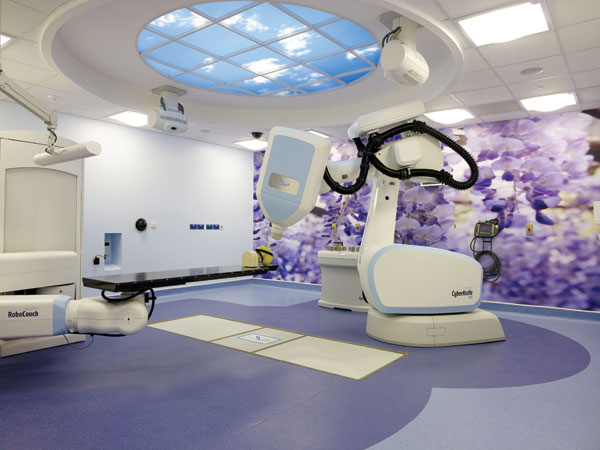
Photo courtesy of Ecore Commercial Flooring
Cyberknife treatment room at Queen Elizabeth Hospital in Birmingham, UK. The striking color and design of the PUR-coated homogenous no-wax vinyl flooring bring positive energy into a potentially stressful experience.
Safety Flooring
Slip resistance in safety flooring is achieved by increasing the friction between the foot and the floor. The friction increase is obtained through the combination of aggregates within the floor, such as quartz, aluminum oxide, recycled natural aggregates, and silicon carbide. Safety floors can also be embossed for enhanced slip resistance, higher friction, good function in wet conditions, and resistance to liquids, oils, and other spills. Some products have a special dimpled texture safe for both water resistance and barefoot use.
Safety flooring, which is important in many areas of a facility, is available in a range of textures from smooth to very prominently embossed. Both sheets and tiles can be used in heavy traffic areas, serving the needs of acuity-challenged patients or patients with shaky mobility, and in ramps used for accessibility and for freight deliveries.
Where there are risks of water spillages and other contaminants, suitable flooring should meet established measures of surface roughness and resistance to wet conditions. In safety flooring for continually wet areas, like around therapy pools, a more prominent emboss is used in conjunction with the aggregates to impart the necessary slip resistance for barefoot users.
Safety flooring can have different aesthetics for different applications, all with the same slip resistance and environmental performance. Aggregate color can be coordinated with surface color, for areas more visible to the public or coordinating with other flooring. Carborundum particles are black and “sparkling,” and are essential for heavy-duty areas, like hospital kitchens or other utility areas, or if a visual reminder is needed for where the “safety space” begins. Aluminum oxide particles are clear and virtually invisible to the naked eye, and impart exceptional hardness and resistance to scratches and abrasion.
Acoustic safety floors add the benefit of impact sound reduction and resistance to sound transmission between rooms.
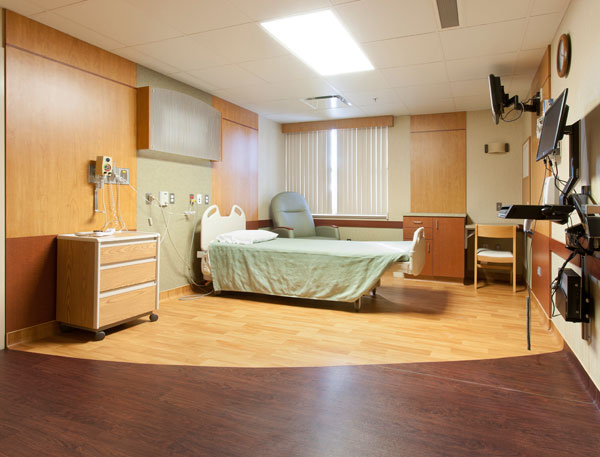
Photo courtesy of Ecore Commercial Flooring
“We want our facility to be a home away from home,” says Eunice Hillman, Construction Liaison for Vernon Memorial Healthcare. The main goal in the recent renovation and new construction was to create a more responsive and need-specific environment through design. “We wanted to use aesthetics to help create a warm but professional look that would improve patient satisfaction, promote healing, enhance visitor comfort, and increase employee productivity.” Over the past three years, the hospital has begun replacing remaining carpeting in all the patient areas. “The flooring we have installed is actually quieter than carpeting, more durable, and easier to clean.” A patient room, shown here.
Evidence-Based Resilient Flooring
Evidence-based design and effective products in healthcare environments deliver multiple benefits for everyone involved. In quiet spaces, patients get better sleep and are less stressed, and staff can communicate and concentrate better. Where patients are safe from injury and infection, staff members are, too. Comforting, attractive spaces promote patient healing, while at the same time encouraging staff morale and the engagement, support, and satisfaction of family and visitors.
Cost benefits multiply, as well, helping providers take advantage of incentives while avoiding costs of patient injury and infection, and realizing long-term savings in labor, energy, cleaning, maintenance, and replacement costs.
As new kinds of healthcare facilities are built and existing buildings are adapted to serve for additional years, investments in evidence-based design and products are an important part of the new value proposition in American healthcare.
Endnotes
- 2015 Hospital Construction Survey (conducted by Health Facilities Management magazine and the American Society for Healthcare Engineering of the American Hospital Association)
- Materials Safety Check from Health Care Design Magazine, November 27, 2013 by Lilliana Alvarado
- Role of the Physical Environment in the Hospital of the 21st Century, Ulrich et al, published by the Center for Health Design, 2004
- Medicare.gov, “Total Performance Score information”
- The role of flooring as a design element affecting patient and healthcare worker safety, Harris, Detke.
- U.S. Occupational Health and Safety Administration (OSHA), “Worker Safety in Your Hospital”
- 2015 National Healthcare Retention & RN Survey, NSI Nursing Solutions Inc.
- Contribution of Floor Treatment Characteristics to Noise Levels in Health Care Facilities (Part 1), Adam Paul and David Arena with John LoVerde & Paul S. Veneklasen Research Foundation, and Eoin King, Ph.D. & Robert Celmer, Ph.D. Director, Acoustics Laboratory
- Preventing Falls in Hospitals, prepared for the Agency for Healthcare Research and Quality by RAND Corporation, Boston University School of Public Health, ECRI Institute
- OSHA, “Worker Safety in Your Hospital”
- American Nurses Association, “Handle with Care Fact Sheet”
- Pilot Cluster Randomised Controlled Trial of Flooring to Reduce Injuries from Falls in Wards for Older People. Drahota et al. Center for Health Design 2013
- Impact of Healthcare Environmental Design on Patient Falls, Gulwadi, Calkins. Published by Center for Health Design and the Coalition for Health Environments Research 2013
- DIN standards are the national system of Germany, equivalent to ASTM. DIN standards on shock absorption are used worldwide to evaluate sports and performance flooring.
- CDC, “Preventing Healthcare-Associated Infections”
- Ambulatory facility design and patients' perceptions of healthcare quality, Becker, Sweeney, Parsons, 2008
 |
| Ecore transforms reclaimed waste into unique surfaces that make people's lives better every day. Can a floor do more? Yes. Ecore products that incorporate its patented itstru technology offer safety, ergonomics, and excellent acoustics, in addition to being sustainable, durable, and easy to install and maintain. www.ecorecommercialflooring.com |


